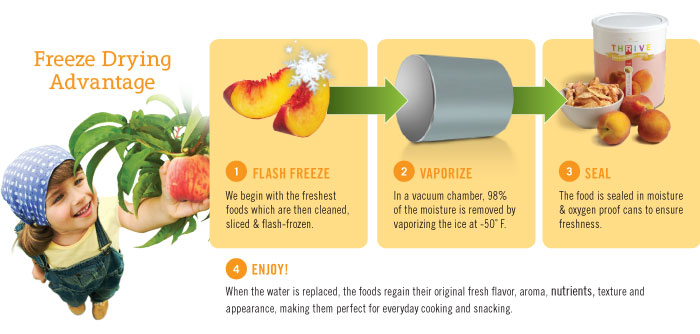

Those happen to have a long shelf life on their own, so freeze-drying isn’t really necessary anyway. Things like peanut butter, chocolate, and honey. The only things that don’t freeze dry well are very high fat or high sugar foods that are low moisture anyway. Anything from freeze-dried meat to Freeze-dried fruit, even freeze-dried cheesecake…it’s all delicious. Other foods don’t dehydrate well, and they won’t ever be the same.įreeze drying, on the other hand, works well for just about any food. Some foods rehydrate well after dehydration, like dried carrots. Sugars in fruits slowly caramelize, proteins slowly cook (or overcook if they’re already cooked), the food shrinks and takes on a rubbery texture. Add water, and they’ll rehydrate easily, and the food will taste more or less as it did before freeze-drying.ĭehydration relies on heat evaporation of water, and that heat changes the food in the process. Since freeze drying works at low temperatures, sugars and proteins within the food remain unchanged. What’s the Difference Between Freeze-Dried and Dehydrated Food? Humans also freeze dry food, and the tradition goes back to the pre-colonial period in the Andes, where potatoes have been freeze dried for at least a thousand years. It’s an archeological phenomenon, but the preservation works the same way, and specimens are preserved indefinitely. In the arctic, animals like seals and penguins that die are sometimes naturally freeze-dried as arctic winds first freeze and then slowly dry the meat. Later on, once all the water has been removed, the food still retains its shape, size, and texture.įreeze drying also happens occurs in nature, outside of a vacuum chamber. At low pressure, ice turns to gas in a process known as sublimation.Įarly in the process, the ice acts as a scaffolding to help the food hold its shape and texture during the freeze-drying process. In a home freeze drying machine, the food is frozen, and then a vacuum pump lowers the pressure in the chamber. How does Freeze Drying Work?įreeze drying is a way to dry foods at low temperatures. I’ll be honest, using an actual freeze dryer is by far the best option, and though they’re an investment, they should pay for themselves in less than a year of regular use. I’ll walk you through different ways to freeze dry food at home, from the traditional methods used in the Andes to freeze-dry potatoes to home-built options, and finally, small freeze dryers for home use. Though freeze-dried food is delicious and handy to have in the pantry, both for everyday cooking and emergencies, it can be expensive. Since it’s heated as it dries, some of the sugars carmelize in fruit, and meat, cheese or egg proteins change, meaning that it’ll never be the same again. On the other hand, Dehydrated food loses its shape and develops a rubbery texture that won’t rehydrate nearly as well. They add incredible flavor to baked goods without the moisture that makes muffins, bread, and cookies soggy.įreeze-dried food holds its shape and quickly rehydrates without losing the flavor, texture, and appearance of fresh food. And most grocery stores carry freeze-dried strawberries, raspberries, and other fruits because they’re used by so many bakers these days. Trader joes sells packs of freeze-dried food right alongside their dehydrated banana chips and raisins. Who needs freeze-dried food besides actual astronauts?įast forward a few decades later, and freeze-dried food is incredibly popular with regular home cooks, and parents are tossing handfuls of freeze-dried fruit into their kid’s lunches as a special treat. Everyone got a kick out of it, and though it was tasty, no one took it seriously. (Though if 2020 taught us anything, it’s that having emergency food on hand isn’t a bad idea.)īelieve it or not, most people that buy freeze-dried food at the store are just using it for everyday meals…because it’s tasty.Ī few decades ago, freeze-dried food was only sold as a novelty, and I remember my parents buying me freeze-dried astronaut ice cream at a ball game as a kid. Contrary to what you might assume, most people don’t use it as lightweight camping food, and most average suburbanites aren’t hoarding it in back closets. I’ll walk you through all the options for freeze-drying food at home and the pros and cons of each method.įreeze-dried food is making its way into more grocery stores and home pantries than ever.


There are a few different ways to freeze dry food at home, both with and without a freeze-drying machine. Freeze drying food seems like space-age technology, but the practice of freeze-drying food actually predates electricity.


 0 kommentar(er)
0 kommentar(er)
